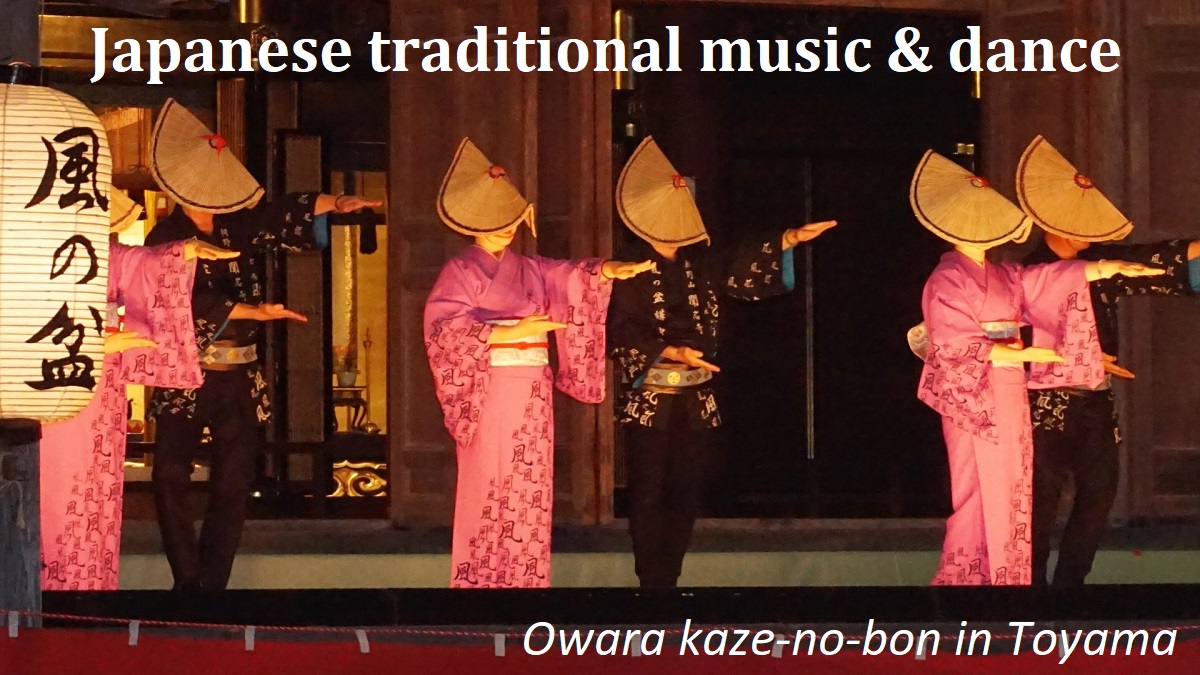Japanese traditional music and dance
Gagaku and Kagura
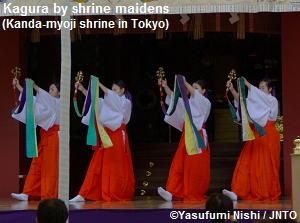
Gagaku
Gagaku is the oldest music in Japan.
It is based on the music for ceremony from old China, Korea or southern Asia, and was formed by the 10th century.
Now Gagaku is played at all ceremonies of Emperor's family.
And we can sometimes hear it at major Shinto shrine.
Gagaku is the music played by an orchestra of Japanese oldest instruments without a conductor.
The sound has magical harmony and is quite different from western music.
Sometimes a dance or a song is added.
The tempo is commonly very slow.
Instruments of Gagaku
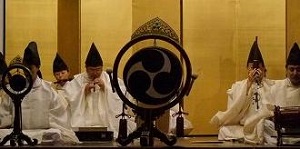
There are three types for the instruments used in Gagaku like western orchestra.
They are wind instruments, string ones, and percussion ones.
In western orchestra, string instruments like violin are main parts, but wind instruments are main in Gagaku.
Wind instruments
Commonly there are three players for each instrument.
- Shou : It's an instrument bundled 17 pipes of bamboo which have different lengths.
This plays the harmony of music. - Hichiriki : It's a small recorder.
This plays the main melody. - Outeki : It's a flute.
There are three kinds of Outeki and they support the sound of Hichiriki.
String instruments
Commonly there are two players for each instrument.
- Biwa : It has four strings, and resembles a guitar.
Usually a plectrum is used to play. - Koto : It's a Japanese harp.
Some strings are set on a lying board.
Percussion instruments
Commonly there is a player for each instrument.
- Kakko : It's a small sideways drum.
This player sets the tempo of music. - Taiko : It's a large drum.
It is hung in a frame. - Shouko : It is a metallic round board like bowl.
Kagura
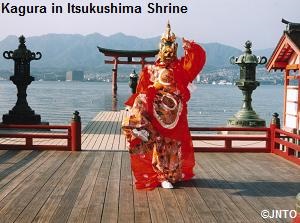
Kagura is the dance for Gods of Shinto.
So we can see it at any Shinto shrine.
It is danced in the festival of each shrine or the ritual of association.
In many case, female attendants of the shrine dance to the Gagaku.
It is very slow and solemn.
And there are the Kagura which has a story of Japanese mythology.
Hougaku
Hougaku means all kinds of Japanese traditional music.
Usually, we use this word except Gagaku and modern Japanese pop music.
So Hougaku contains very various musics.
The music played in Kabuki, Noh, Kyogen and Bunraku are also contained in it.
Many music pieces have songs.
Some songs are sung with chorus, but it is a small-group.
And they are mostly sung in unison.
Additionally, the accompaniment is played only a few instruments.
Of course, there are the music for only instruments.
Usually, when a song is sung, the voice takes the melody line of the music.
And the accompaniments only supports the voice.
Singers chant the words rather than sing a song.
So the melody of Hougaku is ambiguous.
The musical scale of Japanese traditional music is basically a pentatonic scale.
It is D,F,G,A,C in major mode and is E,F,A,B,D in minor mode.
In Okinawan music, it is C,E,F,G,B, so it has tropical mood.
Popular instruments of Hougaku
The popular instruments of Hougaku are the followings.
- Shamisen : It's a plucked string instruments.
It has a drum-like rounded rectangular body, and a thin and long neck without frets.
It has three strings and is played with a plectrum. - Shakuhachi : It's a recorder made of bamboo.
It has no reed, so how to play it is like flute.
The husky sound is unique. - Koto : It's a Japanese harp.
Some strings are set up on the wooden body and body is laid on the floor.
The player plays it in the seiza style (sitting on one's heels). - Fue : It's a Japanese flute.
The formal name is "outeki". - Taiko : It's a Japanese drum and the size is various.
Skins are on one or both heads of wooden cylinder and the player beats with drumsticks.
The performance by only Taiko is popular. - Tsuzumi : It's a portable drum.
The player can beat on the both sides of the drum by hand. - Sanshin : It's the shamisen used in Okinawa.
Snake skin is used on the body.
It is essencial to Okinawan music.
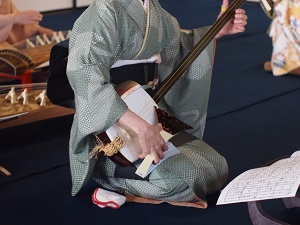
Shamisen
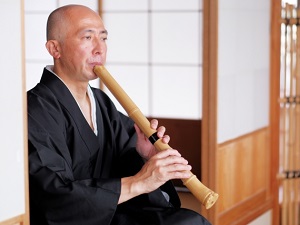
Shakuhachi
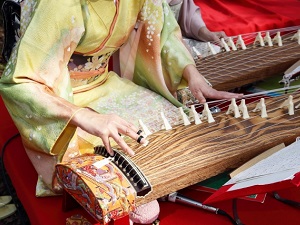
Koto
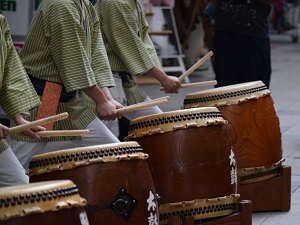
Taiko
Traditional Japanese dance with hougaku
Nihon-buyo
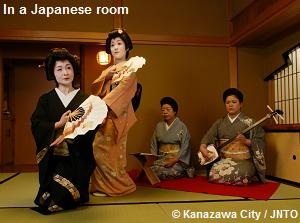
Nihon-buyo is the artistic Japanese dance.
On a stage or in a Japanese room, one or some dancers worn Kimono dance to Japanese music.
The movement is elegant, slow, and varied.
And it expresses the story of the music.
The dance originally came from Kabuki, and the movement and music resemble it.
There are many schools of Nihon-buyo in Japan, and main 5 schools are Hanayagi, Fujima, Wakayagi, Nishikawa and Bando.
"Nihon-buyo" exactly means "Japanese dance" in English, but we use this word in the sense of this artistic dance.
Bon-odori
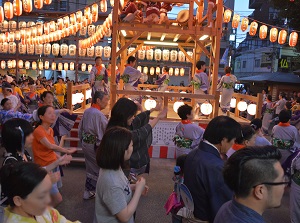
Bon-odori (Bon Dance) means the dance at Bon season.
"Bon" is originally Buddhist event occurring from the 13th to 16th August to hold a memorial service to the spirits of ancestors.
So in the old days, people danced for their ancestors for this time of year.
Recently Bon-odori is danced in various days in summer.
And it is danced in throughout Japan.
Usually Bon-odori is held by each community association.
A tower is made in the center of town square.
A big drum is played on the tower, and many people in the town dance in a round to beat of the drum and music.
Of course, everyone can join it.
The movement of the dance is comparatively slowly, and all people dance with same movement without holding hands or pairing like western folk dance.
In this way, Bon-odori is a civic event, so some big ones are popular nationwide in Japan.
Awa-odori
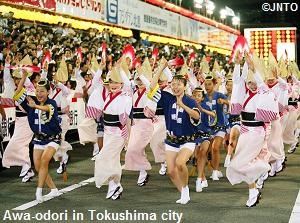
Awa-odori is held in Tokushima prefecture in Shikoku, and it is most famous Bon-odori in Japan.
It is danced as local Bon-odori in each town in the prefecture, but one of Tokushima city is a big festival.
It is held from the 12th to the 15th of August every year and more than one million tourist visit.
Awa-odori is very lively.
The tempo of music is faster than normal Bon-odori, and hand bells are added as a instrument.
Men dance exaggeratingly and funnily, and Women dance modestly.
Commonly many groups called "ren" dance as a team through main streets in Tokushima.
Gujo-odori
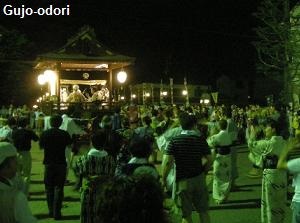
Gujo-odori is the traditional Bon-odori held at Hachiman town of Gujo city in Gifu prefecture, which is a remote mountain city and usually called "Gujo-Hachiman".
It is held at 32 evenings from mid-July to early September, and especially people in the city continues to dance through the night from the 13th to 16th of August.
For this period, about 300 thousand tourists visit this small city.
Around a float of musicians, many dancers of the town dance in a circle to folk music of Gujo.
The dance is relatively easy, so the tourists can join it.
Owara kaze-no-bon
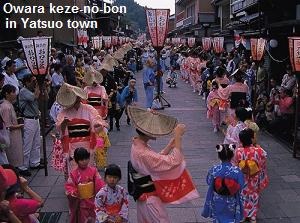
Owara kaze-no-bon is the festival held at Yatsuo town to the south of Toyama city in Toyama prefecture.
It is held from the 1st to the 3rd of September every year, and about 300 thousand tourists visit.
Some music players play the folk song "Owara-bushi", and the dancers of the town go dancing through the narrow streets.
The music is played with adding Chinese fiddle, so it is melancholy.
And the dance also is calm and elegant.
You may feel short on fun, but this naivety is the essence of this festival.
In addition, because of increasing of tourists, the pre-festival is held from the 20th to 30th of August, the dance session is held for tourists and the model dance is performed every evening.
Eisaa
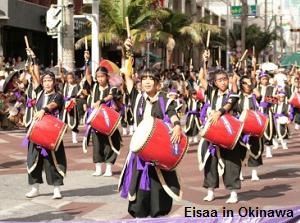
Eisaa is the Bon festival in Okinawa region.
The regional associations of young men hold for their ancestors.
The leader parades with carrying a flag, many men dance with beating drum and women dance with a yotsudake like castanet or a towel.
The men from the association sing the folk songs to "sanshin" of Okinawan instrument.
The team visit door-to-door and they dance at each house.
The culture of Okinawa is different from one of the mainland of Japan, so Eisaa is similar to the festival of Continent a little.
Min-yo (Japanese folk songs)
Min-yo is often translated as Japanese folk songs.
But it may not be the same as the songs of the other countries.
There are many Min-yo all over Japan.
It is a category of Hougaku.
Since a long time ago, people has been singing in each regions.
Min-yo are mostly sung with only voice, but accompaniment is sometimes added on a show.
The famous Min-yo are as follows.
- Sooran-bushi : Southern Hokkaido.
It's a song of herring fishing. - Tsugaru Jongara-bushi : Western Aomori prefecture.
It has virtuoso performance of playing shamisen. - Saitaro-bushi : Miyagi prefecture.
It's a song of great catch of fish. - Aizu-Bandaisan : Aizu region in Fukushima prefecture.
Bandaisan is a volcano, and it's a song of promise of harvest. - Sado-okesa : Sado Island in Niigata prefecture.
It's a song of melancholiness as an outlying island. - Yagi-bushi : Tochigi or Gunma prefecture.
It's a most rhythmical and cheery folk song in Japan. - Tokyo-ondo : For Bon-odori in Tokyo it is composed in 1932.
- Kiso-bushi : Southern Nagano prefecture.
It's a song for Bon-odori of the region in the deep mountains. - Yasugi-bushi : Shimane prefecture.
It has much song, but it is famous as a song of humorous dance for catching loachs in the mud of rice field. - Konpira-funefune : Kagawa prefecture.
It's a song of the god of sea, and "fune" means ship. It's a rhythmical song and endless. - Yosakoi-bushi : Kochi prefecture.
It's a song of a pleasure for adults. - Kuroda-bushi : Fukuoka prefecture.
It's a song of a heavy-drinker of samurai. - Otemoyan : Kumamoto prefecture.
It's a song of a newly-married girl. She already bosses her husband. - Asatoya-yunta : Okinawa prefecture.
It's a love song, but there are various songs which have different words.
The melody is beautiful.

